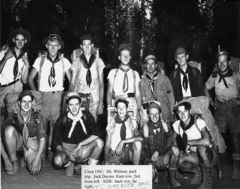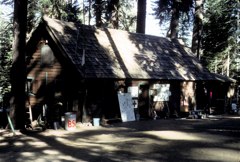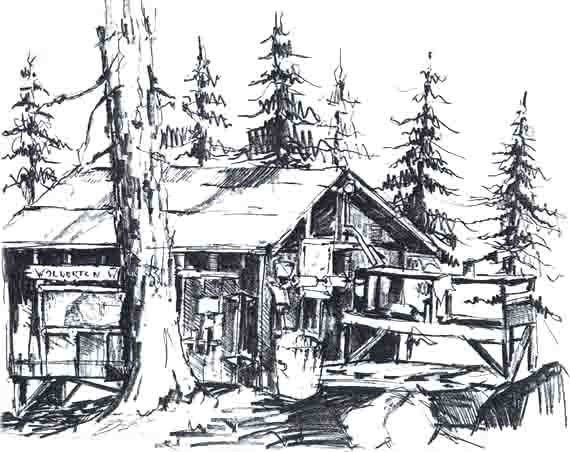The History of Camp Wolverton, BSA
continued
CLICK ON ANY IMAGE BELOW TO ENLARGE IT
Camp Wolverton Before The Boy Scouts
The western slope of the southern Sierra, including the area of Sequoia National Park where Camp Wolverton is located, first became inhabited during the summers by Native American Indians about 500-600 years ago. In fact, just a few years ago, an acorn grinding hole was discovered in the granite bedrock exposed in the old pioneering area at the upper end of Camp Wolverton. Some of the Owens Valley Paiute, or Eastern Mono, settled west of the crest and became the Monache, or Western Mono. They were hunters and gatherers with well-established permanent villages below the 5,000 foot level but generally above the foothill and valley Yokut sites. It was the Potwisha Band of the Monache who frequented the area of Sequoia National Park near Camp Wolverton.
In July 1875, the writer John Muir stayed with a man named James Wolverton. Mr. Wolverton was the “hired man” for cattleman Hale Tharp, and had served in the Civil War under William Tecumsah Sherman. Sherman is known as the Indian-fighter who popularized the saying, “Nits make lice” when asked why the Army insisted on killing women and children. Wolverton found a big tree in the forest and named it after his former commander.
John Muir and James Wolverton stayed in a burned-out fallen sequoia tree near Crescent Meadow. Old post cards called it the Wolverton Log, but it is now known as Tharp’s Log. By 1891, James Wolverton had squatted a cabin with garden at the confluence of the Marble and Middle Forks of the Kaweah River. He died in 1893, leaving the area uninhabited for possibly the first time in 1,000 years.
Between 1905 and 1915, the Mt. Whitney Power Company built roads, including the first road past the future site of Camp Wolverton, to expand their water and power facilities. They stopped at a knoll above Long Meadow and planned to construct a dam there. According to conversations with Rich Stowell, who gained a lot of his information from Bill Tweed of the Park Service, the dam site was about 100 yards past an old logging camp. The logging camp site became the staging area for the dam builders. We know this logging camp site area as the old Order of the Arrow site or Pioneering area at Camp Wolverton.
What we now think of as “Wolverton Meadow” was actually almost 100 acres of forest that was clear-cut during the proposed dam and power plant project (called Kaweah Number 5) on Wolverton Creek. The dam would have been 100 feet high, leaving the future Boy Scout Camp location near the foot of the dam. At that time the land was still privately owned within the Park. Excavation for the foundation of the dam was stopped in 1913 because bedrock was not found in what seemed like a bottomless deposit of glacial debris. Southern California Edison absorbed the Mt. Whitney Power Company and donated Wolverton Meadow and the dam site to the National Park Service between 1916 and 1921.
The Wolverton Dam was part of a larger scheme that extended up the east fork of Kaweah River to Mineral King Valley and which also used water from the Middle Fork. Water from Mineral King is still used for power generation; a huge Pelton Water Wheel can be seen in Three Rivers. Southern California Edison still diverts water from the Middle Fork, at Buckeye Flat. A flume leads down to the Park entrance and a power plant can be seen alongside the river. If you get out of your car at the big Indian Park sign, you can view the plant.
The last grizzly bear in the Wolverton area reportedly died in 1922, leaving only the California Black Bears. There are a lot of black bears around Wolverton!
In 1923, a 4-inch diameter redwood pipeline was run through the future Boy Scout camp from Wolverton Meadow to Giant Forest, delivering up to 350,000 gallons per day. In 1987, while installing a new pipeline to the Lodge, we came across this old redwood pipe. Occasionally, sections of this pipeline can be seen in Camp.
By 1927, day use in the Wolverton Meadow became extensive. That same year, the new General’s Highway was completed past Wolverton to Lodgepole. The old road was replaced in 1957 by the current General’s Highway. We can hike the old road from Camp Wolverton to Lodgepole. Remnants of old road still exist leading to the Sherman Tree and the old Dump. A new road was completed a few years ago that connects the Wolverton Road to a new parking lot for the Sherman Tree. The old road to the horse corrals is closed since the stables are no longer in public operation.
The site of Camp Wolverton was apparently one of 11 Civilian Conservation Corps (CCC) camps used beginning in 1933. One legend has it that the camp Lodge building, still in use today, was built by the CCC. However, we know that is not the case. The truth about the building is revealed later in this book. There are two photos from the 1930’s that are attributed to the CCC camp at Wolverton. One shows road construction and one shows logging, but we cannot determine the exact locations.
Regardless, it appears the Wolverton CCC camp was a non-significant camp, and was used only in the summer. Roy DeVoe of Weldon, California, was a surveyor with the CCC and was known to have lived at Lodgepole and the Wolverton CCC camp from 1933 to 1941.
Even though the Boy Scouts started using Camp Wolverton in 1939 (actually it was called the High Sierra Camp in 1939 and 1940 by the Crescent Bay Area Council), Camp Wolverton and other former CCC camps were used during WWII (1942-45) as temporary summer training, rest, and recuperation sites for soldiers. Also, conscientious objectors (mostly Mennonites) may have lived and worked on National Park maintenance and construction projects out of Wolverton.
Plans submitted by the Park Service in 1942, 1943, and 1944 considered the Wolverton area as a possible concession relocation site. The horse corrals had already moved to the Wolverton area from Giant Forest in 1931 and 1932.
The ski resort at the Wolverton Meadow began in the winter of 1941-42. The ski lifts (with major upgrades through the years [the last one being in the mid-1980’s) operated every winter until they were removed from the area prior to the summer of 1994.
Mike Robbins from the Wolverton Staff was given a copy of an old hand-drawn NPS topo map by Grant Gyllenskog, an NPS surveyor, in the mid 1960’s. It is an amazing map for the history of the Wolverton area. It shows two named cabins, Siebert Cabin and Marshalls Cabin, within the area of Camp Wolverton. The field work for the map was done in 1930 and the map was issued in 1931. During these “quiet years” in the Camp Wolverton area (after the failed dam construction work and before the CCC arrived), the Park had a policy that allowed the development of “semi-permanent camps”. Those “camps” were permanently assigned campsites which often had small cabins on them. Most of these were in Giant Forest, but probably this is the origin of the Siebert and Marshall cabin references on the map. The “semi-permanent camps” policy ended in the early 1930’s and all the permits were revoked.
Camp Wolverton with the Boy Scouts
The exact origins of Wolverton as a Boy Scout Camp are a little foggy. “Lost in antiquity,” as Indiana Jones might say. Alden Barber, a professional Scouter from the Crescent Bay Area Council who later went on to become the National Chief Scout Executive, believes that the National Park administration had designated the Wolverton area for all Scout troops visiting the Park to use. Gradually, the area became a Boy Scout Camp.
 1941 WOLVERTON TO WHITNEY BACKPACKING TRIP 1941 WOLVERTON TO WHITNEY BACKPACKING TRIP |
Beginnings and World War II |
It is believed that the Wolverton area was first used as a Scout Camp in 1939. That is the first year there is a known patch or badge for the camp. The first and second summers it was called the High Sierra Camp. Who ran the camp in 1939 and how it was used is unclear. We don’t know if there was a traditional program that year or if it was a base camp for back county hiking.
In the summer of 1941, Crescent Bay Area Council scout executive “Uncle” Bob Hill assigned Alden Barber to run the camp. It was a unique arrangement because, according to Alden, the Park Service was still involved. The Scouts provided the use of a rustic cabin (not the current lodge) where food could be stored out of a bear’s reach. Troops provided their own food and cooking supplies. Hot showers were available if you brought the firewood to heat the water tank. For the most part, Wolverton was likely a jumping-off place for one day hikes to back country lakes, or for 10 day treks to Mount Whitney and beyond. According to the 1941 camp patch, the Camp was called the Sequoia Camp. Another patch was issued that year for the Scouts who hiked from Wolverton to the top of Mount Whitney. It was a white round felt patch that declared they were members of the 14,496 Club, for the elevation of Mount Whitney.
Alden Barber was the camp director before and after he served with the Army Air Corps during World War II. Working closely with Alden were a crew of successful, motivated young men including John Ehrlichman, Jack Davies, and Martin Michael.
John Ehrlichman went on to greater fame in the 1970’s as a member of Richard Nixon’s “kitchen cabinet.” John was involved in the Watergate Hotel break-in cover-up that eventually led to his incarceration and Nixon’s resignation as president. Getting out of jail, he wrote three mystery novels. Ehrlichman died in 1999. His Tamet Lodge Brotherhood plaque can been seen to the right of the big fireplace at Camp Josepho.
Jack Davies went on to own and operate a very successful winery in Napa Valley. He passed away in 1998, but his Schramsberg winery is still going strong.
An early tradition at Camp Wolverton was singing around the campfire. Martin Weinstein Michael, an Eagle Scout who loved music, wrote the first songs for Camp Wolverton (and Camp Josepho and Emerald Bay too). It has been said that Martin was blind, and that he wrote the camp songs without ever actually seeing the camps. The camps were described to him and then he came up with the songs. He was an accomplished pianist and a successful business man in the advertising and public relations field. He was the founder of the KFI radio show every week that would highlight outstanding Scout troops for one half hour. More information on the KFI show and hiking trips is presented later in this book.
Ehrlichman really helped Barber develop Wolverton, and Davies accompanied Barber on one of the first Camp Wolverton trans-Sierran hikes. Barber, Ehrlichman, Davies, and Michael were responsible (along with others such as Loren Tarvin, Louie Elmendorf, Art Marquez, Albert McCluney, Dick Rice, Harry Bimber, and Paul Weiss) for the development and growth of Camp Wolverton.
In the 1940’s, it was important to take care that nobody felt one camp was being deserted in favor of another. Rivalary between Wolverton and Emerald Bay on Catalina Island may have been intense during your own summer camp days of the 1960’s and 1970’s, but it must have been even worse in the 1940’s.
For example, in 1941, when Camp Josepho was in its first year of operation, Alden created a severe firestorm when he asked to be allowed to lead a group of Explorers on a 10-day hike from Wolverton to Mt. Whitney. His friends and colleagues accused him of sabotaging the summer camp program at Josepho. Alden calmed them down and the pack trip was held with 18 older Scouts who needed more challenges than the traditional summer camp at Josepho. That trip was the beginning of the “High Adventure” concept, later adopted nationally by the BSA.
Because of World War II and the distance between Los Angeles and Wolverton, apparently not much happened with any Scouts at the Camp in 1942, 1943, 1944, or 1945. We have no stories, records, photographs, or patches from those years.
 THE LODGE IN 1965 THE LODGE IN 1965 |
The Lodge |

